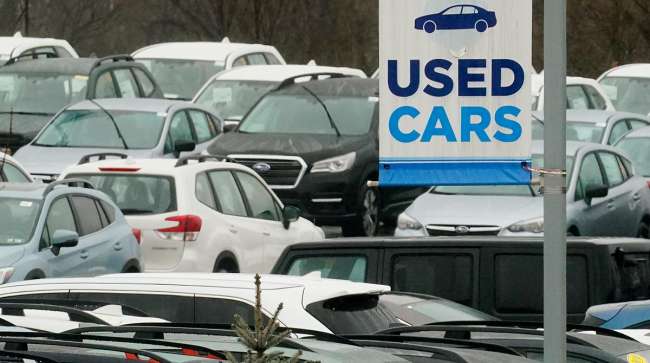Associated Press
Inflation Rises for First Time in a Year to 3.2% Rate

[Stay on top of transportation news: Get TTNews in your inbox.]
WASHINGTON — Inflation in the United States rose in July after 12 straight months of declines, boosted by costlier housing. But excluding volatile food and energy prices, so-called core inflation matched the smallest monthly increase in nearly two years.
The inflation figure the government reported Aug. 10 showed that consumer prices increased 3.2% from a year earlier. That was up from a 3% annual rise in June, which was the lowest rate in more than two years. The July inflation figure remained far below last year’s peak of 9.1%, though still above the Federal Reserve’s 2% target.
The Fed, economists and investors, though, pay particular attention to the core inflation figures for signs of where inflationary pressures might be headed. From June to July, core inflation remained a tame 0.2%.
The price data will be among the key barometers the Fed will weigh in deciding whether to continue raising interest rates. In its drive to tame inflation, the Fed has raised its benchmark rate 11 times since March 2022 to a 22-year high.

Housing costs remain high. (Elaine Thompson/Associated Press)
A jump in energy prices has rekindled some of the inflation pressures underlying the economy. Gasoline prices have surged nearly 30 cents over the past month to a national average of $3.83 a gallon, according to AAA.
Economists say that in the fight to conquer inflation, the easy progress has likely already been achieved. Gasoline prices, for example, though liable to bounce around from month to month, have already plunged from a peak national average of more than $5 a gallon, which was reached in June of last year after Russia’s invasion of Ukraine.
Much of the inflationary surge that began in 2021 was caused by clogged supply chains: Ports, factories and freight yards were overwhelmed by the explosive economic rebound from the pandemic recession of 2020. The result was delays, parts shortages and higher prices. But supply chain backlogs have eased in the past year, sharply reducing upward pressure on goods prices. Prices of long-lasting manufactured goods actually dipped in June.
Now, the Fed faces a daunting problem: persistent inflationary pressures in service businesses — restaurants, hotels, entertainment venues and the like — where wages represent a substantial share of costs. Worker shortages have led many of these services companies to sharply raise pay.
Last week, for example, the Labor Department reported that average hourly wages rose 4.4% in July from a year earlier, more than expected. To cover their higher labor costs, companies have typically raised their prices, thereby fueling inflation.

Host Michael Freeze clarifies the differences between predictive and preventive maintenance. He gives fresh commentary on everything from how enhanced connectivity boosts your preventive maintenance plans to what predictive possibilities AI can offer your shop. Tune in above or by going to RoadSigns.ttnews.com.
Another factor working against continued declines in year-over-year inflation rates is that prices soared in the first half of last year before slowing in the second half. So any price increase in July would have the effect of boosting the year-over-year inflation rate.
Still, economists caution against reading too much into one month of numbers. Many of them expect inflation to continue trending lower.
Used car prices, which had skyrocketed after the pandemic, have been edging down: They dropped 5.1% in July from a year earlier to $29,198, according to Edmunds.com. July of last year was near the peak of used car price spikes, resulting from a scarcity of new vehicles caused by a global computer chip shortage. Buyers who wanted new vehicles but couldn’t find them entered the used market, sending used prices sharply higher.
This year, though, used vehicle prices began to drop once automakers managed to acquire more chips and could produce more new vehicles. Many shoppers who were forced to buy used are now back in the new vehicle market. Used vehicle prices are expected to decline, at least modestly, through the year.
Despite chronic concerns about higher labor costs, one closely watched measure of wages and salaries — the Labor Department’s employment cost index — grew more slowly from April through June. Excluding government jobs, employee pay rose 1%, less than the 1.2% increase in the first three months of 2023. Compared with a year earlier, wages and salaries grew 4.6%, down from a year-over-year increase of 5.1% in the first quarter.
Rents, which had soared after the pandemic, are also cooling. Researchers at the Federal Reserve Bank of San Francisco wrote this week that “year-over-year shelter inflation will continue to slow through late 2024 and may even turn negative by mid-2024.”
Want more news? Listen to today's daily briefing above or go here for more info
Fed officials will have plenty of data to absorb before deciding whether to continue raising rates. The Aug. 10 report is the first of two CPI numbers the policymakers will see before their next meeting Sept. 19-20. In addition, their favored inflation gauge, called the personal income expenditures price index, comes out on Aug. 31. And the August jobs report will be released Sept. 1.
Many economists and market analysts think the Fed’s most recent rate hike in July will prove to be its last: Nearly 87% of traders expect no Fed hike next month, according to the CME Group’s FedWatch Tool.
Tom Krisher in Detroit contributed to this report.




